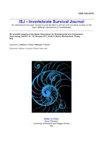Ecotoxicity of hallachrome, an unusual 1-2 anthraquinone excreted by the infaunal polychaete Halla parthenopeia: evidence for a chemical defence?
IF 1.2
4区 农林科学
Q4 IMMUNOLOGY
引用次数: 2
Abstract
Polychaetes play a prominent role in marine systems, but little is known about their secondary metabolites compared with other benthic taxa. In the present study, we investigated the toxicity of hallachrome, an unusual 1-2 anthraquinone identified from the skin of some polychaetes, including the Mediterranean infaunal species Halla parthenopeia. Under stress conditions, this worm releases a harmful purple mucus, whose noxious compounds were still unknown. We hypothesized that hallachrome also occurs in the purple mucus, giving rise to its color and toxicity. Soon after the production of the purple exudate, H. parthenopeia also secretes a harmless, transparent mucus, which pushes away the toxic one, suggesting protective functions for the worm itself. LC-MS and 1H-NMR analyses confirmed the presence of the pigment hallachrome in the purple mucus. The average concentration of the pigment in the purple mucus was about 310 mg L-1. Ecotoxicological bioassays on representative species of bacteria, protozoans, rotifers, crustaceans (Artemia franciscana) and polychaetes (Dinophilus gyrociliatus) revealed its severe toxic effects: LC50/EC50 values ranged from 0.11-5.67 mg L-1. Hallachrome showed higher toxicity for A. franciscana than other naturally occurring anthraquinones. Tests on encapsulated embryos of D. gyrociliatus evidenced the ability of a mucus layer to limit hallachrome diffusion, confirming the protective role of the transparent mucus. Given the information available on polychaetes anti-predator strategies, hallachrome cannot be considered a consumer deterrent. However its toxicity and wide range of activity suggest chemical defensive functions against potential competitors, parasites and/or pathogens.一种不寻常的1-2蒽醌,由水生多毛动物Halla parthenopeia排泄:化学防御的证据?
多毛动物在海洋系统中发挥着重要作用,但与其他底栖动物类群相比,对其次生代谢产物知之甚少。在本研究中,我们研究了hallachrome的毒性,hallachrome是一种罕见的1-2蒽醌,从一些多毛类动物的皮肤中鉴定出来,包括地中海水生物种Halla parthenopeia。在压力条件下,这种蠕虫释放出一种有害的紫色粘液,其有毒化合物尚不清楚。我们假设紫色粘液中也会出现幻色原,从而产生紫色粘液的颜色和毒性。在产生紫色分泌物后不久,孤雌虫也会分泌一种无害的透明粘液,将有毒的粘液推开,这表明蠕虫本身具有保护作用。LC-MS和1H-NMR分析证实紫色粘液中存在色素hallachrome。紫色粘液中色素的平均浓度约为310 mg L-1。对细菌、原生动物、轮虫、甲壳类动物(Artemia franciscana)和多毛纲动物(Dinophilus gyrociliatus)的生态毒理学生物试验表明,其毒性较强,LC50/EC50值为0.11 ~ 5.67 mg L-1。汉草酮对金合欢的毒性高于其他天然蒽醌类。对旋毛虫囊化胚胎的实验证明,黏液层具有限制毛胚色素扩散的能力,证实了透明黏液的保护作用。鉴于有关多毛类反捕食者策略的现有信息,hallachrome不能被认为是一种消费者威慑。然而,它的毒性和广泛的活性表明它对潜在的竞争对手、寄生虫和/或病原体具有化学防御功能。
本文章由计算机程序翻译,如有差异,请以英文原文为准。
求助全文
约1分钟内获得全文
求助全文
来源期刊

ISJ-Invertebrate Survival Journal
IMMUNOLOGY-ZOOLOGY
CiteScore
2.10
自引率
0.00%
发文量
0
审稿时长
>12 weeks
期刊介绍:
Invertebrate Survival Journal (ISJ) is an international and open access journal devoted to prompt and innovative studies on the basic defense mechanisms in invertebrates, in particular with a view to identifying biotechnologies able to act against derived diseases and related economic damage.
Contributions will be mainly in the form of Letters to the Editor, Visions and Perspectives, Short Communications, Technical Reports, Research Reports, Review, Minireview and Reports of Meetings. Letters to the Editor can be commentaries or perspectives on invertebrate defence mechanisms or replies to the data published in ISJ.
 求助内容:
求助内容: 应助结果提醒方式:
应助结果提醒方式:


